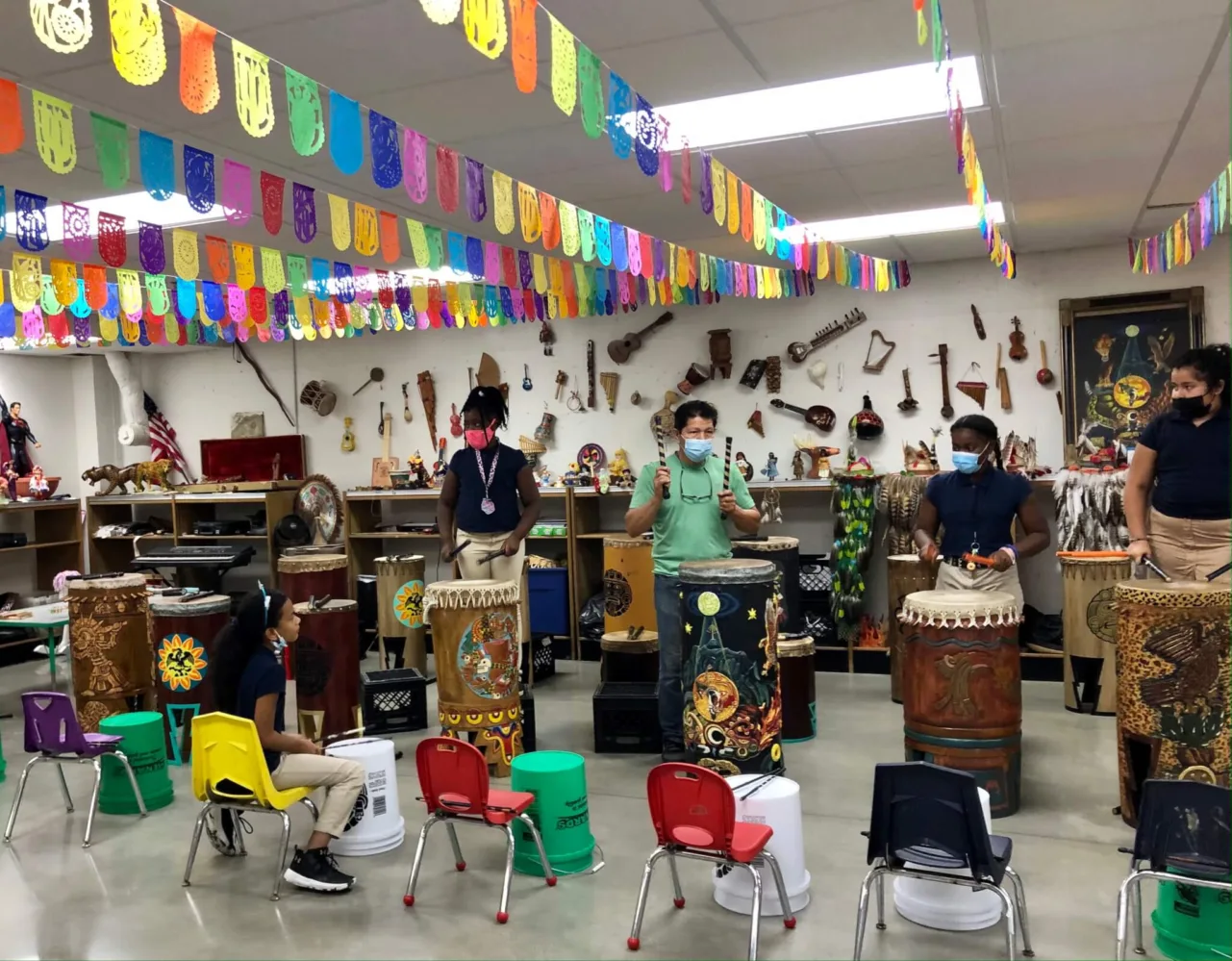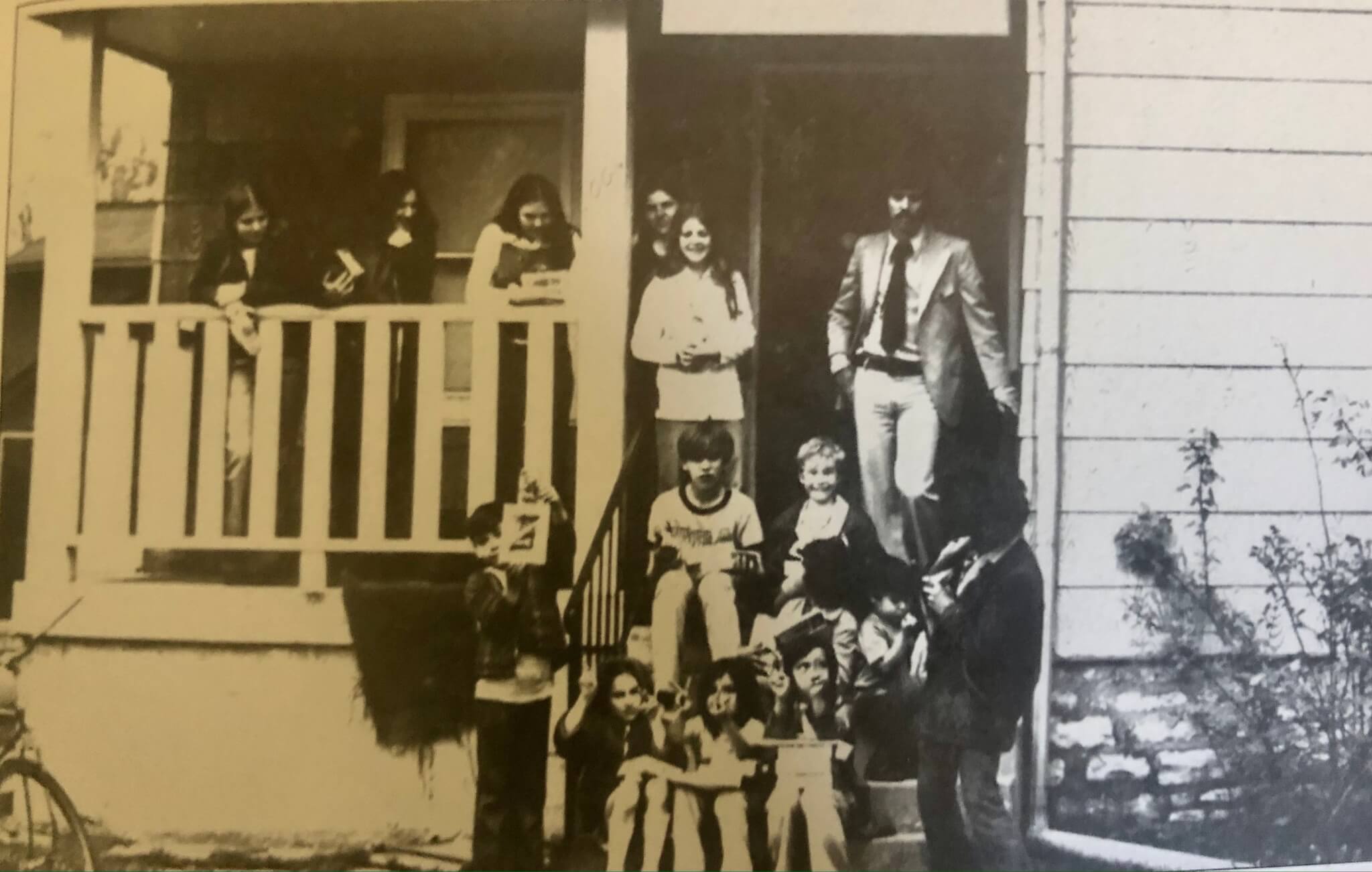
#image_title
Agency has served the Latino Community and others in need for more than 50 years
If you stand outside Jesus Avila’s classroom on any given afternoon, you might hear the equivalent of musical thunder—the sound of his students pounding out ancient rhythms on traditional Aztec drums.
“It’s all wrists. It’s all wrists,” shouts Avila, reminding his students to stay on the beat. “Even though it may look like it’s arms. It’s all wrists.”
Avila’s Cultural Awareness class is a favorite of students at La Casa de Esperanza Charter School, who enjoy getting a chance to learn about Hispanic, Latino, and African cultures through music, dance, and art.
On this particular October afternoon his students—a group of curious and squirrely 4th graders—are learning about the history of Mexico City’s first peoples.
“Underneath Mexico City, there is another city that exists, and slowly, when buildings collapse, they find thousands and thousands of items that were made by the ancient people: The people called Nahua Mexica or Aztec,” says Avila showing his students a small beaded necklace. “This is one of the pieces. It’s all tiny little skulls made out of jade. This was made some thousand years ago and it’s precious.”
La Casa’s charter school serves 211 students prekindergarten through 6th grade, providing students in grades 4K through 2nd Grade with the option of attending dual language classes where instruction takes place in both English and Spanish.
“It’s so exciting to see these kids. You’ll come in and say something and they’ll all answer in Spanish or they’ll all answer in English” says La Casa’s President and CEO Shari Campbell.
Building History
Once just a far off dream of La Casa de Esperanza board members and boosters, today the charter school is just one of many missions of a wide-reaching community-servicing agency, one that first got its start in a little house on Waukesha’s near-northside.
While Wisconsinites often associate Waukesha as long being home to a mostly white, nondescript populace, the city has long had a robust Hispanic community. According to Census data, 21,835 Hispanics live in Waukesha County today.
Far from a new phenomenon rooted in contemporary immigration issues, Latinos first began arriving in the city of Waukesha and its environs in the 1920s and 30s.
Hailing from Mexico, Texas, and states across the Midwest, many came to the area as migrant farm workers. Those families soon started settling permanently in the city and its outskirts as they got jobs as factory workers.

But the Latino families who began establishing roots in the community soon realized there were few resources available to help them assimilate or at least make their way in a new country and city where few people outside their closely knit neighborhoods understood Spanish.
It wasn’t until 1966 that three couples, who later became known as the History Builders, decided that more needed to be done to help the growing number of native Spanish speakers in the community learn English.
“They were not Hispanic, but they saw the need,” explained Carmen De La Paz, a longtime La Casa employee who still does some public relations for the agency. “It started in a Bible study in church. The challenge to those people that were in the Bible study was to go into the community and to see what was needed.”
RELATED: From Farms to Factories to New Businesses, Latinos Have Made a Mark on Wisconsin’s Economy for More Than a Century
The group eventually found their way into Waukesha’s Hispanic community, which was then limited to streets like The Strand and Raymond Avenue—and established English language classes, holding them at a little house on Ryan Street.
“Those three ladies—they went house to house offering the English language classes to the women. So Carol Warren was in charge of the English class, and the other two ladies offered to care for their children,” said Carmen.
Later the group started offering classes on Saturdays for the men.
A Growing Mission
When the History Builders handed leadership of the organization to the Latino community in 1969 , there was a contest held among the youth to name the new organization. The winning name was La Casa De Esperanza or “House of Hope.
“I always told Duane [one of the men who started History Builders], you never realized it at the time, but you were building history,” De La Paz said.

Today, La Casa provides a variety of services to the Waukesha community, providing schooling, daycare and Head Start services to children of all stripes, as well as elder care services, weatherization services, and a home buyer and financial literacy course for any adult who may need the help.
The programs are a natural outgrowth of La Casa’s foundational mission, which was originally to improve the lives of Hispanic families in the community, but has grown to include all lower-income groups.
“Over the years, like with any nonprofit, funding goes up and down and some programs we add, and some programs go away. But still today we are focused on the workforce, helping people find jobs, helping people get better jobs, helping people get training, and teaching them how to manage their money,” Campbell said.
Most of the organization’s offices, including the school and daycare, are located in a one-time warehouse at 410 Arcadian Ave., which has been renovated and expanded various times to allow for the growth of its various staff and services.
Making Waukesha Home
For De La Paz one of the greatest missions La Casa has had over the years is its fight for fair housing for Latinos, a fight that continues to this day as it works with families to help them eventually become homeowners. Its weatherization program, for instance, is a direct outgrowth of its original efforts to help Latinos deal with and battle against substandard housing.
But it wasn’t always easy.
When Carmen and her family first settled in Waukesha, for instance, they moved into an apartment on Newhall Avenue, a neighborhood where Hispanics did not live at the time. Carmen recalls that the family across the street threatened to sell their home if a “Puerto Rican family” moved onto the street.
“At first it was bad, but my husband said ‘we have to show them who we are,’ and little by little they accepted us,” Carmen recalls.
A few years later the family again encountered discrimination after moving to a house on Summit Avenue, which was almost entirely white at the time. Eventually the petty abuses visited upon the family subsided.
Those experiences helped inform Carmen and other members of La Casa’s fight for fair housing for Latinos in the 1960s and beyond. Sometimes all it took was a simple phone call to root out racist landlords.
“First we sent somebody like me with a heavy, heavy accent like me, to call, and the landlord would say ‘I’m sorry but the apartment is already rented, and then the other person, who had no accent, would call, and they would say the apartment was available,” De La Paz said.
But it’s been those efforts, combined with La Casa’s focus on education, that have helped make Waukesha the kind of place that De La Paz and other Hispanics, are proud to call home.
“I always say that La Casa is the best kept secret in Waukesha,” De La Paz said. “From that little small house (on Ryan Street), we created a monster. That little thing just grew. It was like a giant woke up, and just look at what we have today.”

Wisconsin unveils blackout, retro yellow license plates
It was a long road to bring blackout license plates to Wisconsin. First, a constituent who saw the black-and-white design explode in popularity in...

Rural resilience runs deep but crisis looms for WI schools
By Judith Ruiz-Branch Wisconsin educators are shedding light on the unique dilemma rural school districts face as they work to meet a large...

Tree-mendous news: This year’s Capitol Holiday Tree will be harvested in Oconto County
The 2025 Capitol Holiday Tree will stem from Oconto County. Here are all the fun details. This year’s Capitol Holiday Tree will be harvested in...
The disappearance of La Crosse teen Evelyn Hartley: A deep dive into the case
La Crosse teenager Evelyn Hartley went missing in 1953 while babysitting. Here’s everything you need to know about her unsolved case. This article...




